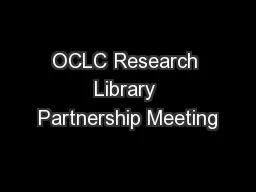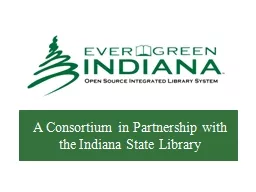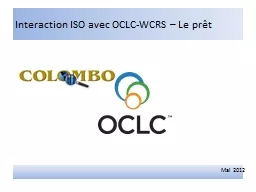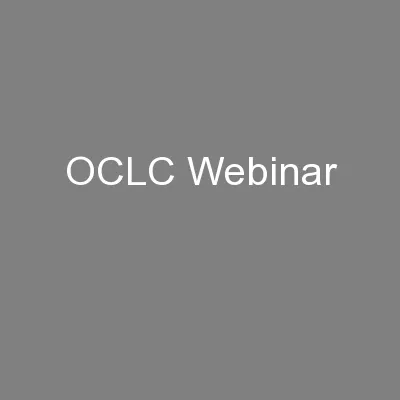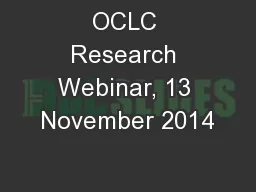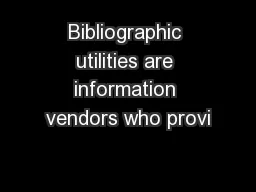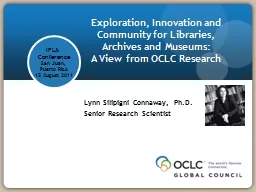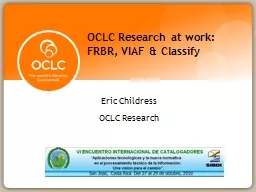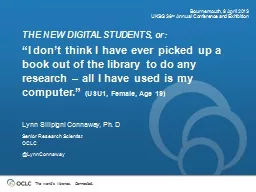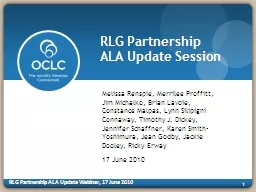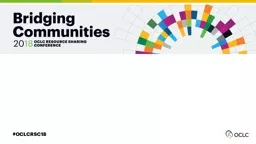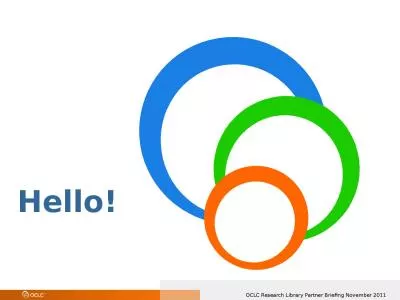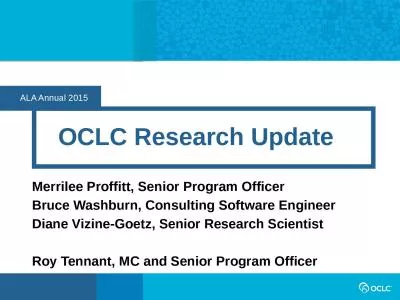PPT-OCLC Research Library Partnership Meeting
Author : pasty-toler | Published Date : 2017-05-05
Melbourne Australia 2 December 2015 Working with OCLC Research Library Partners on Researcher amp Organisational Identifiers Karen SmithYoshimura OCLC Research
Presentation Embed Code
Download Presentation
Download Presentation The PPT/PDF document "OCLC Research Library Partnership Meetin..." is the property of its rightful owner. Permission is granted to download and print the materials on this website for personal, non-commercial use only, and to display it on your personal computer provided you do not modify the materials and that you retain all copyright notices contained in the materials. By downloading content from our website, you accept the terms of this agreement.
OCLC Research Library Partnership Meeting: Transcript
Melbourne Australia 2 December 2015 Working with OCLC Research Library Partners on Researcher amp Organisational Identifiers Karen SmithYoshimura OCLC Research Fundergovernmentled initiatives to . . . Making Unique & Distinctive Collections Work . Exeter, 22 March 2013. Titia van der Werf. Senior Program Officer. OCLC Research. Some context: OCLC Research in Europe and in the UK. Identifying shared interest areas between RLUK and OCLC Research. Evergreen Indiana History. Project discussion began in December 2007. 108 Letters of Interest. First Meeting of Libraries in April 2008. 20 Pilot Libraries. Executive Committee elected August 2008. Consortium parameters set. Mai 2012. Interaction ISO avec OCLC. La présentation qui suit, décrit l’interopérabilité ISO entre VDX et OCLC-WCRS pour les demandes d’emprunt. Il sera maintenant possible d’envoyer des demandes dans OCLC-WCRS directement à partir de VDX.. – 21 May, . 2015. Carol Jean . Godby. , Senior Research Scientist. Library Linked Data in the Cloud . Shenghui. Wang, Research Scientist. Jeffrey K. . Mixter. , Software Engineer. Our collaborators. Karen Smith-Yoshimura, OCLC Research. Registering Researchers. in . Aut. hority Files . Laura Dawson, . Bowker. Andrew MacEwan, British Library . Philip Schreur, Stanford University. Daniel Hook, Symplectic LTD. .. A definition of bibliographic utilities as given by W. . Saffady. : “Bibliographic utilities” is the collective name for a group of computer service organizations that maintain large data bases of cataloging records, and offer various cataloging support services and related products to libraries and other customers who access those records on an online, timesharing basis. . A View from OCLC Research. Lynn Silipigni Connaway, Ph.D.. Senior Research Scientist. Topics. About OCLC Research. How activities originate. How projects are chosen. Sample projects. OCLC Research. Focus:. OCLC Research at work: FRBR, VIAF & Classify Eric Childress OCLC Research Outline Overview of OCLC Research FRBR (Functional Requirements of Bibliographic Records) - related work VIAF (Virtual International Authority File) – . all I have used is my computer.” . (USU1, Female, Age 19). THE NEW DIGITAL STUDENTS, or:. Bournemouth, 9 April 2013. UKSG 36. th. Annual Conference and Exhibition. Lynn . Silipigni. . Connaway. Melissa Renspie, . Merrilee. . Proffitt. , Jim . Michalko. , Brian Lavoie, Constance . Malpas. , Lynn . Silipigni. . Connaway. , Timothy J. Dickey, Jennifer Schaffner, Karen Smith-Yoshimura, Jean . 28 September 2015. @. LorcanD. http://photos.nd.edu/image/I0000zhFgnbUJDqY. Research. Programs. Research Library Partnership. WebJunction. . Member. relations. Membership and Research. Prelude . Collection: centers and comps. institutions. Teva Sweet, Atlanta university center, Robert w. woodruff library. ILL Unit Head. Teva Sweet. Serving four institutions. AUU ILL Unit Monthly Report - April 2017. ILLiad. Web Reports User Status April - 2017. San Mateo, CA Dublin, OH. Leiden, NL . . OCLC . Research Library Partnership. US & . Canada. (Americas). 119/78%. Asia-. Pacific. 7/4%. Europe &. Middle East (EMEA). 27/18%. OCLC Research Library Partnership. Merrilee. . Proffitt. , Senior Program Officer. Bruce Washburn, Consulting Software Engineer. Diane . Vizine. -Goetz, Senior Research Scientist. Roy Tennant, MC and Senior Program Officer. Wikipedia and Libraries.
Download Document
Here is the link to download the presentation.
"OCLC Research Library Partnership Meeting"The content belongs to its owner. You may download and print it for personal use, without modification, and keep all copyright notices. By downloading, you agree to these terms.
Related Documents

